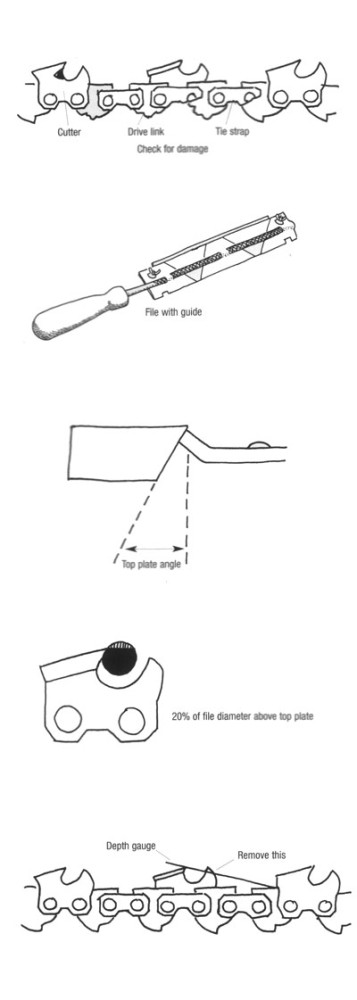Cutting with a dull chain will increase wear on both you and your saw and increase the risk of kickback. How do you know when a chain is dull? A saw with a dull chain doesn’t pull itself into the wood, and it produces sawdust rather than chips.
If you are just learning to sharpen, it is best to practice on a new chain that has become dull for the first time, since the angles and heights should still be close to ideal.
Before sharpening, clean any oil and grease from the chain to prevent build-up in your file’s teeth, then inspect the chain for broken cutters, tie straps, or drive links. Inspect your saw’s sprocket regularly, and replace it if it’s worn.
Next, ensure that the chain is properly tensioned. If it is too loose, it will wobble, and you won’t be able to file it correctly. If it is too tight, you won’t be able to advance the chain around the bar.
Use a file guide. It will help you maintain the proper filing angle and will produce a much more accurate and consistent job than doing it freehand. Different chains have different specifications for the proper file size and the top and side plate angles. Consult the owner’s manual or the saw shop for the specifications for your chain and adjust the file guide accordingly. The file guide will also maintain the proper depth of the file, which should leave about 20 percent of the file’s diameter above the height of the top plate.
Do not bear down too hard – let the file do the work. File until any nicks and damages are removed. Make sure that you file all the top plates to the same length. Look at the corner of the cutting blades on the teeth. If you see a clean, thin, chrome edge, the chain is sharp. Advance the chain to the next tooth. Sharpen all of the teeth on one side before you change the guide angle to work on the teeth on the other side.
After every three or four sharpenings, it is a good idea to check your depth gauges (sometimes called rakers). Always use a guide. The guide fits over the tooth, allowing the depth gauge to show through a slot in the guide. File the gauges down to the level of the guide.
After sharpening and adjusting depth gauges, clean off any particles; then lubricate the chain thoroughly with bar and chain oil.
Once the chain is sharp, make every effort to keep it that way. Cover the bar and chain during transportation or storage, and avoid having it contact dirt, rocks, metal, or other objects.
Also, keep your files clean and protected. Replace the file every five or six sharpenings, and don’t let your new files clang around in a toolbox unprotected. Wrap each new file in cloth after coating it in lightweight machine oil. That way they’ll stay in top shape, ready for use.



Discussion *